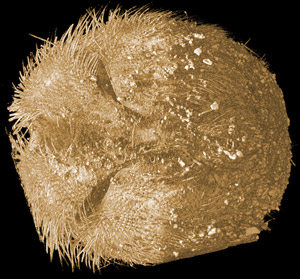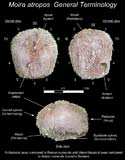Moira atropos belongs to Spatangoida, the heart urchins. There is no common name known for M. atropos. This species, which can grow up to 3.3 cm in length, shows typical spatangoid behavior, living in muddy sediment or fine sands. The surrounding material is ingested through the mouth and passed through the huge digestive tract, where organic components of the sediment are absorbed. In order to reach new areas with high organic content, this “irregular” sea urchin plows slowly through the sediment.
Moira atropos is characterized by deeply depressed aboral petals and a narrow, depressed anterior furrow. It lacks the Aristotle’s Lantern or chewing apparatus found in regular sea urchins. Instead, it builds a tunnel through the sediment to the seafloor surface using tube feet from the anterior furrow, bringing detritus down and into the mouth. The thin test is fragile and easily broken, but the animal burrows for protection. Known predators include starfish and the margate fish Haemulon.
Moira atropos is distributed in the northwest Atlantic, North Carolina and Bermuda southward through the Greater and Lesser Antilles, Gulf of Mexico, Central and South America to Brazil. It lives at depths up to 445 m, but most commonly less than 50 m. It is a typical burrowing spatangoid sea urchin in that it prefers muddy, fine sediments.

About the Species
This specimen was collected by Kükenthal & Hartmeyer at Coral Bay, St. John, US Virgin Islands. Professor Georg Willy Kükenthal (1861-1922) and Dr. Heinrich Robert Hermann Hartmeyer (1874-1923) visited St. John during their “Westindienreise” in 1907. Kükenthal was a professor of zoology in Jena, Wroclaw, and Berlin, and Hartmeyer was curator of the ZMB marine invertebrate collection from 1908-1923. Generations of German zoologists have studied anatomy from “Kükenthal – Zoologisches Praktikum.”
The specimen was scanned for Dr. Alexander Ziegler of Freie Universitaet Berlin.

About this Specimen
This specimen was scanned in May 2007 by Mr. Heiko Temming at the Max-Planck-Institut für evolutionäre Anthropologie using a SkyScan 1172. The isotropic voxels measure 0.01739 mm.

About the
Scan
Literature
Chesher, R. H. 1963. The morphology and function of the frontal ambulacrum of Moira atropos (Echinoidea: Spatangoida). Bulletin of Marine Science of the Gulf and
Caribbean 13:549-573.
Hendler, G., J. E. Miller, D. L. Pawson, and P. M. Kier. 1995. Sea Stars, Sea Urchins, and Allies: Echinoderms of Florida and the Caribbean. Washington, D.C., Smithsonian Institution Press, 390 p.
Mortensen, T. 1928-1951. A Monograph of the Echinoidea. Copenhagen, C.A. Reitzel.
Schultz, H. 2006. Sea Urchins, a guide to worldwide shallow water species. Augsburg, Scientific Publications, 484 p.
Links
Moira page on The Echinoid Directory (Natural History Museum, London)
M. atropos page on Echinoids.nl

Literature
& Links
Front page image.
|
 |

Additional
Imagery









